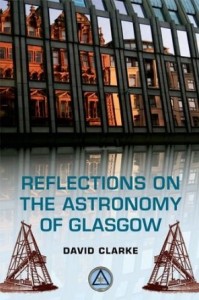500 years of Glasgow Astronomy

Dr David Clarke (Honorary Research Fellow and ex-Observatory Director) has written a book on the history of astronomy in Glasgow titled “Reflections on the Astronomy of Glasgow: A story of some 500 years” (Edinburgh University Press). In it David describes how astronomy contributed to the educational enlightenment of Glasgow and to its society and commerce.
The book is available at a special price from Edinburgh University Press till 30-Sep-2013 via this form and is also available on amazon.
How Astronomy contributed to the educational enlightenment of Glasgow, to its society and to its commerce
The book provides a comprehensive narrative concerning Glasgow’s connections with Astronomy since the University’s establishment in 1451. It covers the educational and scientific contributions of notable and sometimes notorious individuals, providing biographies of outstanding people, including George Sinclair, the Professors Dick , the Professors Wilson, James Watt, John Pringle Nichol, Robert Grant, Ludwig Becker and William Smart. Through such people, discoveries related to sunspots, the monochromaticity within light, the behaviour of dew-point and the discovery of infra-red radiation remarkably have Glasgow connections.
The early part nineteenth century saw a thirst for astronomical knowledge by the local population with the establishment of two public observatories in the City. The second was rescued financially by the University in 1845 with a remit for establishing a time service for shipping on the Clyde. Following ‘Glasgow’s Big Bang of 1863’, with an unwarranted Edinburgh intrusion for establishing a time-gun, the resulting spat was covered in heated exchanges in the Herald with the editor demeaning of the title of Astronomer Royal for Scotland; in the end the local Horselethill Observatory won out to provide telegraphic time signals for the control of City public clocks. The establishment of eight different observatories is described with details of their architecture.
Overall, the story is a collection of local material and its relationship to the general development of the subject of astronomy, with insights on commercial and social aspects, so supporting a unique picture of astronomical connections with the City of Glasgow.